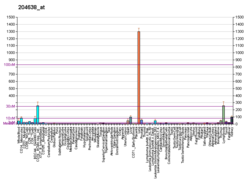Tartrate-resistant acid phosphatase (TRAP or TRAPase), also called acid phosphatase 5, tartrate resistant (ACP5), is a glycosylated monomeric metalloprotein enzyme expressed in mammals.[5] It has a molecular weight of approximately 35kDa, a basic isoelectric point (7.6–9.5), and optimal activity in acidic conditions. TRAP is synthesized as latent proenzyme and activated by proteolytic cleavage and reduction.[6][7] It is differentiated from other mammalian acid phosphatases by its resistance to inhibition by tartrate and by its molecular weight.
The mechanism of phosphate ester hydrolysis by TRAP is through a nucleophilic attack mechanism,[8] whereby, catalysis occurs with the binding of a phosphate-substrate to the Fe2+ in the active site of TRAP. This is then followed by a nucleophilic attack by a hydroxide ligand on the bound phosphorus atom, resulting in cleavage of the phosphate ester bond and production of an alcohol. The exact identity and mechanism of the hydroxide ligand is unclear, but it is thought to be either a hydroxide that bridges the metal ions within the active site or a terminal hydroxide bound to Fe3+, with conflicting reports for both mechanisms.
- ^ a b c GRCh38: Ensembl release 89: ENSG00000102575 – Ensembl, May 2017
- ^ a b c GRCm38: Ensembl release 89: ENSMUSG00000001348 – Ensembl, May 2017
- ^ "Human PubMed Reference:". National Center for Biotechnology Information, U.S. National Library of Medicine.
- ^ "Mouse PubMed Reference:". National Center for Biotechnology Information, U.S. National Library of Medicine.
- ^ Baumbach GA, Saunders PT, Ketcham CM, Bazer FW, Roberts RM (July 1991). "Uteroferrin contains complex and high mannose-type oligosaccharides when synthesized in vitro". Molecular and Cellular Biochemistry. 105 (2): 107–117. doi:10.1007/bf00227750. PMID 1922010. S2CID 30416983.
- ^ Ljusberg J, Ek-Rylander B, Andersson G (October 1999). "Tartrate-resistant purple acid phosphatase is synthesized as a latent proenzyme and activated by cysteine proteinases". The Biochemical Journal. 343 Pt 1 (1): 63–69. doi:10.1042/0264-6021:3430063. PMC 1220524. PMID 10493912.
- ^ Ljusberg J, Wang Y, Lång P, Norgård M, Dodds R, Hultenby K, et al. (August 2005). "Proteolytic excision of a repressive loop domain in tartrate-resistant acid phosphatase by cathepsin K in osteoclasts". The Journal of Biological Chemistry. 280 (31): 28370–28381. doi:10.1074/jbc.M502469200. PMID 15929988.
- ^ Klabunde T, Sträter N, Fröhlich R, Witzel H, Krebs B (June 1996). "Mechanism of Fe(III)-Zn(II) purple acid phosphatase based on crystal structures". Journal of Molecular Biology. 259 (4): 737–748. doi:10.1006/jmbi.1996.0354. PMID 8683579.





